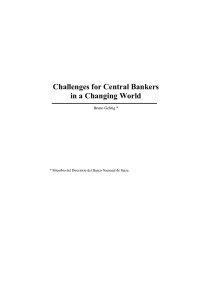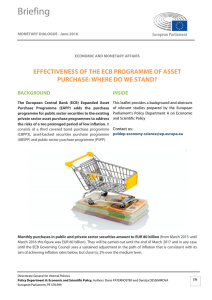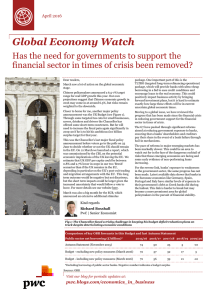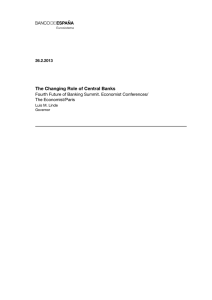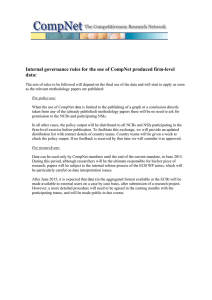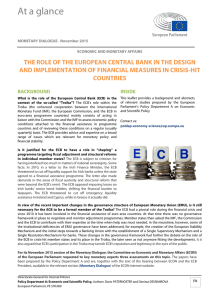AF-CA IT 2N trim 2016 EN.indd - Crèdit Andorrà Financial Group
Anuncio
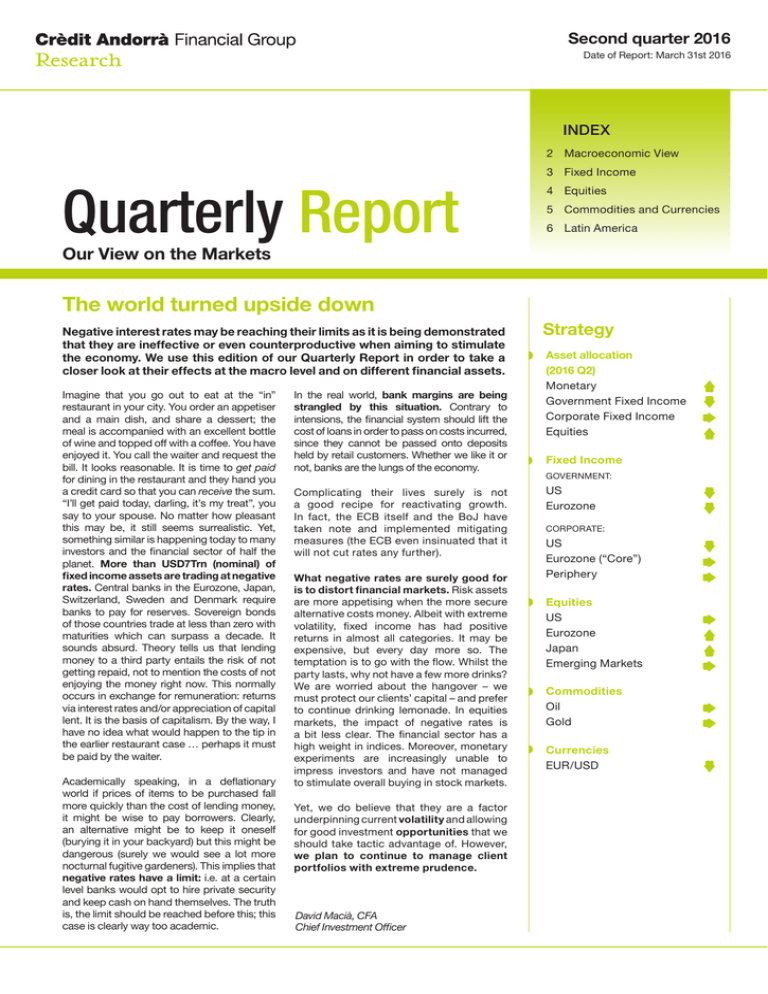
Second quarter 2016 Date of Report: March 31st 2016 INDEX 2 Macroeconomic View Quarterly Report 3 Fixed Income 4 Equities 5 Commodities and Currencies 6 Latin America Our View on the Markets The world turned upside down Negative interest rates may be reaching their limits as it is being demonstrated that they are ineffective or even counterproductive when aiming to stimulate the economy. We use this edition of our Quarterly Report in order to take a closer look at their effects at the macro level and on different financial assets. Imagine that you go out to eat at the “in” restaurant in your city. You order an appetiser and a main dish, and share a dessert; the meal is accompanied with an excellent bottle of wine and topped off with a coffee. You have enjoyed it. You call the waiter and request the bill. It looks reasonable. It is time to get paid for dining in the restaurant and they hand you a credit card so that you can receive the sum. “I’ll get paid today, darling, it’s my treat”, you say to your spouse. No matter how pleasant this may be, it still seems surrealistic. Yet, something similar is happening today to many investors and the financial sector of half the planet. More than USD7Trn (nominal) of fixed income assets are trading at negative rates. Central banks in the Eurozone, Japan, Switzerland, Sweden and Denmark require banks to pay for reserves. Sovereign bonds of those countries trade at less than zero with maturities which can surpass a decade. It sounds absurd. Theory tells us that lending money to a third party entails the risk of not getting repaid, not to mention the costs of not enjoying the money right now. This normally occurs in exchange for remuneration: returns via interest rates and/or appreciation of capital lent. It is the basis of capitalism. By the way, I have no idea what would happen to the tip in the earlier restaurant case … perhaps it must be paid by the waiter. Academically speaking, in a deflationary world if prices of items to be purchased fall more quickly than the cost of lending money, it might be wise to pay borrowers. Clearly, an alternative might be to keep it oneself (burying it in your backyard) but this might be dangerous (surely we would see a lot more nocturnal fugitive gardeners). This implies that negative rates have a limit: i.e. at a certain level banks would opt to hire private security and keep cash on hand themselves. The truth is, the limit should be reached before this; this case is clearly way too academic. In the real world, bank margins are being strangled by this situation. Contrary to intensions, the financial system should lift the cost of loans in order to pass on costs incurred, since they cannot be passed onto deposits held by retail customers. Whether we like it or not, banks are the lungs of the economy. Complicating their lives surely is not a good recipe for reactivating growth. In fact, the ECB itself and the BoJ have taken note and implemented mitigating measures (the ECB even insinuated that it will not cut rates any further). What negative rates are surely good for is to distort financial markets. Risk assets are more appetising when the more secure alternative costs money. Albeit with extreme volatility, fixed income has had positive returns in almost all categories. It may be expensive, but every day more so. The temptation is to go with the flow. Whilst the party lasts, why not have a few more drinks? We are worried about the hangover – we must protect our clients’ capital – and prefer to continue drinking lemonade. In equities markets, the impact of negative rates is a bit less clear. The financial sector has a high weight in indices. Moreover, monetary experiments are increasingly unable to impress investors and have not managed to stimulate overall buying in stock markets. Yet, we do believe that they are a factor underpinning current volatility and allowing for good investment opportunities that we should take tactic advantage of. However, we plan to continue to manage client portfolios with extreme prudence. David Macià, CFA Chief Investment Officer Strategy Asset allocation (2016 Q2) Monetary Government Fixed Income Corporate Fixed Income Equities Fixed Income GOVERNMENT: US Eurozone CORPORATE: US Eurozone (“Core”) Periphery Equities US Eurozone Japan Emerging Markets Commodities Oil Gold Currencies EUR/USD Macroeconomic View Business interest rate (> 1year) Negative limits For years the ECB has been announcing measures aimed at reducing interest rates in order to reactivate inflation. Yet, we are still without inflation and interest rates have fallen to unseen –even negative– levels. But, how did this happen? And, more importantly, where are we heading? Source: ECB Bank lending rates have fallen significantly in the last few years. Interest rate on overnight deposits Source: ECB The cost of bank liability has got a limit which we are close to achieving. It is difficult that it drops below 0%, as clients might withdraw their money. European sovereign bond interest rate A single interest rate does not exist. Firstly, we have official interest rates (set by the ECB). Currently, the ECB establishes three official interest rates applied to financial institutions: i) for emergency lending (0.25%); ii) for lending under normal conditions (0.0%); and iii) the rate “paid” to banks for deposits placed at the central bank (-0.40%). These three interest rates and expectations regarding their future trends, as well as other factors, affect other interest rates, which we would classify into two large categories: i) interest rates in the capital markets (government and corporate bonds) which in many cases are currently negative; and ii) bank interest rates for lending to companies and households which, according to the latest ECB data, amply surpass the level of 2%. That said, these two categories of interest rates are, in most cases, at historic lows. This reflects the ECB’s decisions, and the same situation has also affected other types of interest rates albeit at different speeds and, most importantly, with different limits. We think the ECB still has enough influential power to continue to cut interest rates in capital markets, but this is not the banking sector’s case. Thus, the speed of execution of the ECB’s decisions in capital markets has increased since arbitrage opportunities can be taken advantage of with greater agility as markets are more liquid and comprised of agents with investment needs (banks, mutual funds, insurance companies, etc.). A decision by the monetary authority is able to reach financial markets in -practically- a matter of seconds whilst possibly taking several quarters to penetrate the entire banking system. Source: ECB However, for other kinds of debt, such as bonds and, especially, sovereign bonds, interest rates could possibly drop even more. 2 The difference in limits is even more important. Therefore, we believe that the ECB does not face any limits when continuing to have a downwards impact on interest rates in capital markets, but that this is not the case of bank rates. In the former case, this reflects the fact that in capital markets the ECB is implementing an additional measure: its so-called QE programme: i.e. the purchase -with new money created by the ECB- of public and private bonds. This tool ensures on-going pass-through of official interest rates, no matter how negative. In other words, if somebody purchases 30% of €5 bills at a price of €5.1, then the price will shift to €5.1. In the latter case, banking sector interest rates can only fall to a certain limit since if new ECB cuts are passed through to bank rates, the capacity of financial institutions to generate profits would be greatly affected and, thereby, their ability to grant loans: unless negative interest rates are applied to client deposits of banks (probably not possible as at some point clients would withdraw money held in bank deposits). Therefore, if much more negative official rates were not passed through to households and companies, it would no longer make sense to implement them. This is the European case, in our view, since the lion’s share of financing is via the banking system which does –as previously commented– have limits. That said, some economists are already proposing solutions (e.g. putting limits on deposit outflows). Moreover, there is already talk of nonconventional monetary policy 2.0 in order to reactivate inflation: imagine €1,500 transferred from the ECB to each citizen or that the ECB acquired bank loans or invested in stock markets. In conclusion, if implementation of negative rates is aiming to reactivate inflation, it looks like we are at or close to reaching the limit: at least with the current rules of the game. Pablo Manzano, CFA Fixed Income Portfolio Manager Fixed Income Red code from Tokyo to Stockholm Implementation of negative interest rates in an aim to stimulate economic growth at a time of weakness has triggered a debate regarding its effectiveness. We will see if it spurs the relaunch of lending to the economy, although we must watch for negative consequences and their impact on bond markets. The unprecedented implementation of negative interest rates in the history of the global economy reflects the downtrend in inflationary expectations and the nonconfessed goal of depreciating one’s own currency. The underlying aim of all of the above is to stimulate the economy at a time of weakness. Five central banks -Japan, the Eurozone, Denmark, Switzerland and Swedenare charging financial institutions for outstanding deposits held with them. The Euribor interbank rate is negative for terms of up to 12 months. Half of the European public debt has negative yields (with Switzerland in negative territory for terms of up to 15 years, Germany for up to 7 years, France for up to 5 years, and Spain and Italy for up to 2 years). In Japan, up to 70% of outstanding debt is in negative territory and only terms of greater than 10 years have positive yields. On the corporate investment grade side, 10% of issues in the Bloomberg (BERC) index are trading in negative territory with issuers such as Danone, Bayer, Nestlé, Shell, Pfizer and Unilever charging investors for buying their bonds. Over the short term, technical factors and the arrival of a “new” buyer will still predominate. In bond markets this situation has also led to the flattening of interest rate curves and low or even negative yields, as we have seen. Debate has begun regarding its effectiveness and the possible negative consequences that it may trigger: Maximum maturity of negative interest rate bonds negative rates might be at this time, debt should be paid down. As a % of GDP it totals 227.9% in Japan, 135.8% in Italy, 101% in Spain and France and over 90% in the UK. Lower liquidity: The economic crisis has underpinned a deleveraging process that, combined with central banks’ measures, has flooded the world with liquidity. However, on the contrary, the liquidity of bond markets is deteriorating: it is less deep, volumes of trades are smaller, and there are greater impacts on sale prices. This situation largely reflects the fact that central banks are buying these assets and driving out traditional investors. Greater risk taking by investors: They are likely to be tempted to seek returns and, inevitably, end up investing in assets with higher betas but that raise the overall risk of their portfolios. Clearly, we would insist on carrying out risk/return analyses and implementing rigorous risk control processes. According to a Bloomberg survey of 63 economists with coverage of the earliermentioned central banks, interest rates should remain in negative territory until 2018. Moreover, over the short term, new asset purchase programmes as well as the increase in the size of existing ones announced at the last ECB meeting in March should underpin on-going upside speculation in bond markets. Indeed, it is evident that technical factors are likely to prevail vs. fundamentals. During 2005 Greenspan referred to the performance of long-term interest rates as a “conundrum.” Based on the performance, in general, of global bond markets, it would make sense to recover this definition. Source: Bloomberg Most European countries have a negative part in their interest rate curve. We can find cases such as that of Switzerland, where the government is financed at a negative rate to as far as 18 years. Official Rates: Consensus Forecasts (%) 31/03/162Q’16 3Q’16 4Q’16 Eurozone 0,000,000,000,00 US 0,500,650,750,95 United Kingdom 0,50 0,50 0,55 0,60 Interest Rates: Changes (%) Last 3 Last year 31/03/16 months Zona Euro 3-month Euribor -0,24 -0,11 -0,11 10-year Bund 0,15 -0,48 -0,48 EE.UU. 3-month US Libor 0,63 0,02 0,02 10-year US 1,77 -0,50 -0,50 Reino Unido 3-month GBP Libor 0,59 0,00 0,00 10-year Gilt 1,42 -0,55 -0,55 Greater volatility: Central banks’ usage of negative interest rates is causing a period of greater market volatility and in some cases it has spurred investors to seek safe haven in US Treasury bonds or in gold. Stimulation of leverage by governments: The drop in the cost of debt to negative levels eliminates restrictions of governments’ increases in debt. Yet, no matter how Josep M Pon, CIIA Head of Fixed Income 3 Equities Coping with negativity European Banking Sector vs EuroStoxx 50 Financial sector stress threatened to increase downside risks to growth. The ECB responded with new easing measures exceeding expectations and managing to offset bank funding concerns. Source: Bloomberg There has been a clear under performance of the banking sector since October 2015. European Banks look cheap on historical basis Source: Bloomberg The banking sector is trading well below its historical price to book average of 1,26x. Discount due to numerous headwinds. EMERGING MARKETS JAPAN EUROPE USA 4 S&P 500 DJ Indus, Avg Q1 % 2016 % 2,060 0.77% 0.77% 17,685 1.49% 1.49% NASDAQ 100 4,484 -2.39% -2.39% DJ Euro STOXX 50 € 3,005 -8.04% -8.04% France (CAC 40) 4,385 -5.43% -5.43% Spain (Ibex 35) 8,723 -8.60% -8.60% UK (FTSE 100) 6,175 -1.08% -1.08% Germany (DAX) 9,966 -7.24% -7.24% Switzerland (SWISS) 7,808 -11.46% -11.46% Italy (FTSE MIB 30) 18,117 -15.41% -15.41% Netherlands (AEX) 440 -0.39% -0.39% TOPIX 1,347 -12.93% -12.93% NIKKEI 225 16,759 -11.95% -11.95% Mexico 45,881 6.76% 6.76% Brazil 50,055 15.47% 15.47% Argentina 12,99211.28% 11.28% China 3,004 -15.12% -15.12% India 25,342 -2.97% -2.97% Korea 1,996 1.76% 1.76% Russia 1,871 6.23% 6.23% Faced with slowing growth, the ECB made another attempt to encourage loan growth and now charges banks 0.40% to hold excess reserves. In order to mitigate this extra cost and calm market concerns regarding bank funding, the monetary authority also announced four new cheap funding programs contingent on banks indeed lending more. If banks pass negative rates onto customers, the latter might simply withdraw their savings. When negative rates were first introduced in late 2014 there were only €100Bn in excess reserves representing an annual cost of around €0.2Bn. Before the March ECB meeting, the negative deposit rate stood at -0.30% which cost the European banking industry €2Bn/year (ten times more but still a manageable charge) for excess reserves of €672Bn (up almost seven fold). The main earning’s drag is not the charge for excess reserves but rather the downtrend in net interest income. cut SME deposit rates to below zero but this move was widely unpopular and we have yet to see EU banks follow suit. In order to mitigate negative rates, banks have intensified their focus on restructuring, cutting costs and lifting fees. Other options are upward adjustments to mortgage spreads successfully carried out in Sweden and Denmark but more difficult in regions with fixed mortgage rates (France, Germany, Belgium and the Netherlands) or where banks are unable to change spreads over the life of the loan (Spain and Italy). Overall, we remain cautious on the sector especially in a slow growth environment that puts pressure on the ECB to cut rates further despite its rhetoric against such moves. Although valuations seem to discount lower returns, there are no catalysts in sight and the sector still faces regulatory capital uncertainties. We prefer banks with high capital ratios and scope for further restructuring and cost-cutting. Banks generate income thanks to the difference between interest earned on loans and interest paid on deposits. With interest rates at all-time lows, margins are squeezed as clients’ deposits are inelastic to rate cuts whilst loans have a more floating rate nature. Banks are thus receiving less interest from loans whilst still paying the same interest on a €8.7Trn deposit base which is already approaching the 0% rate bound. The fear is that if banks pass on negative rates to customers, the latter might simply withdraw their savings. Of course it is not that easy as storage and insurance costs must be considered. Moreover, although holding cash might not seem that farfetched for smaller retail customers, corporate and institutional clients, with large cash balances, would not be able to do so. When the Danish Central Bank cut its deposit rate to -75bp, Danish banks did Jadwiga Kitovitz, CFA Head of Equity and Institutional Accounts Commodities and Currencies COMMODITIES Impact of low interest rate scenario Commodities account for one-fourth of global trade which, in turn, amounts to one-fourth of global GDP. As a result, its price is impacted mainly by the economic cycle (supply and demand), inflation, foreign exchange rates (the majority of commodities are traded in USD) and monetary policies. Therefore, it is worthwhile showing empirical evidence of the reaction commodity prices to interest rate fluctuations: to react positively to unexpected increases in rates. This reflects expected inflation, but normally occurs because central banks aim to put a brake on the pace of growth of overheated economies. You can judge for yourself… Currently, have Fed interest rate hikes been accompanied by an overheating of the US economy? Bjornson and Carter (1997) assert that at the beginning of a recession the demand for commodities is low, which drives down prices. However, when central banks cut interest rates, prices should recover. We would bear in mind that since Bernanke said the word “tapering” for the first time at the beginning of 2013, there has been a massive collapse of commodities prices. If you think that the economy is going to overheat, then invest in commodities. On the contrary, it only makes sense to take positions in raw materials if you think that the Fed will end up feeling trapped and that its measures will mirror those of other central banks under a scenario of low rates. Historically, under scenarios of low rates precious metals have registered the best reactions to further interest rate cuts. To the contrary, Armesto and Gavin (2005) see evidence that commodities prices tend Miguel Ángel Rico Investment analyst Frankel (2006) explained the inverse relationship between interest rates and commodities prices. His main argument is that during times of lower interest rates, speculators have greater incentives to exit fixed income – which offers them lower returns – and invest in commodities. YTD performance of DJ UBS TR commodities Source: Bloomberg Commodities vs USD CURRENCIES A global monetary policy? Economic theory regarding the transmission of monetary policy explains how the decisions of a central bank affect the real economy. Therefore, under normal circumstances, it indicates that interest rate cuts should drive up company and household demand for loans, lift exports thanks to depreciation of the currency and propel consumer spending due to greater wealth on the back of appreciation of financial assets. Moreover, inflation should rebound thanks to economic growth and higher import prices. Yet, in reality the situation is more complex and it is indeed quite difficult to observe the fruits of interest rate cuts. Thus, in the Eurozone, inflation amounts to -0.2%, corporate lending is increasing at a pace of +0.6% y-o-y, and first quarter GDP growth amounted to +0.3% q-o-q. From these results we can conclude that we are – probably – not currently experiencing normal circumstances and that monetary policies are unlikely to end up being as effective as central bankers would like. Structural factors such as high debt of economies, aging populations, and stagnating productivity of some sectors are probably putting a damper on economic growth. However, in spite of not managing to reactivate growth, the ECB’s monetary policies have strongly depreciated the Euro. Presently, other countries such as Sweden, Switzerland, and Denmark have negative rates that distort their exchange rates. These distortions have effects at the global level as they lead to strong capital movements. In many cases, developed countries can cope with these movements but they can be destabilising for emerging markets which have suffered extreme volatility in their currencies in recent years. Thus, the Governor of the Central Bank of India Raghuram Rajan’s proposal is very interesting: He calls for a set of international regulations limiting implementation of certain monetary measures either permanently or temporarily. He recently wrote that “We can pretend all is well with the global financial non-system and hope that nothing goes spectacularly wrong. Or we can start building a system for the integrated world of the 21st century”. Pablo Manzano, CFA Fixed Income Portfolio Manager Source: Bloomberg BRL Implied volatility Source: Bloomberg During the last few years, the volatility of emerging currencies has increased excessively. Even though this is a result of many factors, one of them has been the implementation of unconventional monetary measures by developed central banks. Exchange rate $/€ % change: Consensus forecast: 1 month 3 months 1 year 4.71% 4.83% 5.73% 2Q 2016 2016 2017 1.08 1.09 1.11 5 Latin America Real GDP Latam In the eye of the hurricane Abundant global liquidity has helped Latin America to better digest the bursting of the commodity bubble. However, deep reforms are needed to create new sources of growth in a global “low growth environment” in which ultra-easy monetary policy in the developed world is becoming ineffective. Source: Bloomberg Latin America is likely to stay in recession in 2016. Inflation After a tough 2015, at first glance, the environment for Latin American economies has recently improved. Commodity prices have rebounded and the imminent threat of rising rates in the US has been postponed. This should give the region’s leaders some additional breathing room and time to adjust their economies to weather the new global economic realities albeit at the cost of (even) lower economic growth this year. The real challenge for the region is to control inflation and implement deep structural reforms to boost human, physical and regulatory infrastructure. This is the only way to find new sources of growth, now that the commodity and credit booms have effectively faded away. Structural reforms are the only way to find new sources of growth. Source: Bloomberg Inflation should reach its peak in 2016. Budget and Current Account Balance Fuente: Bloomberg Fiscal and Current Account Deficits make the region vulnerable if global liquidity dries up. 6 The problem is that domestic politics have their own cycles and characteristics. In Brazil, for example, in addition to external risks the country is paralysed by the on-going political crisis, new corruption scandals and the possible impeachment of President Dilma Rousseff. Consequently, the deep recession that started in 2014 is likely to continue throughout the rest of 2016. Real GDP might contract even more sharply than the -3.8% suffered in 2015 with inflation still close to 10% despite the 16 interest rate hikes since 2013 that have lifted the target interest rate from 7.25% to 14.25%. If the rebound in commodity prices continues and there is rising hope for positive political change, Brazilian assets (that have become cheap) might rebound dramatically. On the other hand, if global liquidity dries up –or central bank easing gets less effective–, the political mess in Brazil intensifies and commodity prices stay depressed, asset prices in Brazil could fall much further. In the meantime, we expect to see sharp rallies and corrections underpinned by hopes and worries, rather than real economic fears. The consequent volatility makes Brazil an undesirable market for conservative private investors. Some of the better managed economies –such as Mexico and Peru– that have adjusted their economies to face external shocks are better positioned to weather the storm. After an orderly slowdown, there are initial signs of an economic rebound in these countries. However, they are not free of political risks and asset prices remain correlated to global growth prospects, commodity prices and sentiment towards the region in general. Perhaps it is better to focus on countries and segments that have benefitted the least from the last decade’s commodity boom and easy access to credit. One such example is Argentina, where the new administration has made impressive progress on the reform and macroeconomic fronts in order to rebalance the economy. Pascal Rohner, CFA Director of Latam Equities Disclaimer This document has been prepared by Credit Andorrà Financial Group. This document is for distribution only as may be permitted by law. It is not directed to, or intended for, distribution or use by any person or entity who is a citizen or resident of or located in any jurisdiction where such distribution, publication, availability or use would be contrary to law or regulation or would subject Crèdit Andorrà Financial Group to any registration or licensing requirement within such jurisdiction. The information contained in this document represents the opinion of Crèdit Andorrà Financial Group’s analysts on markets and could be modified and/or updated without prior warning. This document is published for general background information purposes, and although the information and data herein are obtained from sources believed to be reliable, neither Crèdit Andorrà Financial Group nor any of its analysts guarantee or take the responsibility that the information contained herein is complete or accurate. Financial analysts and any other relevant people involved in the preparation and dissemination of this document are independent of those holding a significant interest in the purpose of the report. In no event, a compensation has been received from issuers or there is a commitment or engagement in order to produce favourable reports. Statements included in this document, including opinions, projections and estimates, are nonfactual in nature and assume certain economic conditions and industry developments, and constitute only current opinions that are subject to change without notice. Certain information contained herein constitutes “forward-looking statements”, which can be identified by the use of forward-looking terminology such as “may”, “will”, “should”, “expect”, “anticipate”, “project”, “estimate”, “intend”, “continue” or “believe”, or the negatives thereof or other variations thereon or comparable terminology. Due to various risks and uncertainties, actual events or results or their actual performance may substantially differ from those reflected or contemplated in such forward-looking statements. As a result, they must not be taken into account either as a reliable source of future performances or guarantee to reach such outcomes. Data related to outcomes of financial instruments, financial indices, financial measures or investment services that may be contained in this document, may be conditioned by commissions, fees, taxes or associated expenses to be borne by such gross results, prompting, among other things, a decrease on the outcomes that may be either higher or lower depending on the particular circumstances of the investor. This document does not constitute an offer on behalf of Crèdit Andorrà Financial Group nor any of its analysts. This document is not in any case intended to be taken as a buy or sell personal recommendation on neither assets, nor a representation that any investment strategy or recommendation is suitable or appropriate to an investor’s individual circumstances. Neither this document nor its contents shall form the basis of any contract, commitment or decision of any kind. The relevant readers shall make their decisions based on their own analysis and with the advice of independent advisors that they deem appropriate. In any case, it will not be understood that in distributing the present document neither Crèdit Andorrà Financial Group nor its analysts are making any personal investment recommendations. Trading in financial markets can involve considerable risks and requires constant monitoring of current positions. Neither Crèdit Andorrà Financial Group nor its analysts, employees or managers assume any liability for any investment or disinvestment decisions based on this publication, nor for any losses that could result from investment or disinvestment decisions based on this document. Any statements contained in this document referred to information, opinions or data provided by a third party will represent in any case Crèdit Andorrà Financial Group’s interpretation of such data, provided either publicly or through a subscription service. Such use and interpretation have not been reviewed by the aforementioned third party; therefore, neither Crèdit Andorrà Financial Group, its affiliates nor its analysts offer any guarantees, either express or implicit, regarding their accuracy, integrity or correctness. The information contained in this publication is strictly confidential. No part of this publication may be reproduced, transformed, distributed, published, forwarded or used in any manner without the prior written permission of its author. Any publication, modification or update of this material is subject to variable periodicity and does not imply any obligation on behalf of Crèdit Andorrà Financial Group. Note for: Andorran investors: this document has been prepared by Crèdit Andorrà Financial Group, and it is distributed by either Crèdit Andorrà, SA or CrediInvest, SA, both entities authorised, regulated and supervised by the Institut Nacional Andorrà de Finances (INAF). Spanish investors: this document has been prepared by Crèdit Andorrà Financial Group and it is distributed by Banco Alcalá, SA, entity authorised, regulated and supervised by the Banco de España and the Comisión Nacional del Mercado de Valores (CNMV). US investors: this document has been prepared by Crèdit Andorrà Financial Group and it is distributed by Beta Capital Management, LLC (IARD No. 154894), a registered investment adviser approved to conduct business on October 2012, and authorized, regulated and supervised by the US Securities and Exchange Commission (SEC). Luxembourg investors: this document has been prepared by Crèdit Andorrà Financial Group and it is distributed by Banque de Patrimoines Privés, SA, entity authorised, regulated and supervised by the Commission de Surveillance du Secteur Financier (CSSF). Swiss investors: this document has been prepared by Crèdit Andorrà Financial Group and it is distributed by Private Investment Management, SA, entity authorised, regulated and supervised by the Association Suisse des Gérants de Fortune. This document is not a product of any Financial Research Unit and it is not subject to the Directives on the Independence of Financial Research of the Swiss Bankers Association. This document has not been prepared in accordance with the legal and regulatory requirements that promote the independence of research and it is not subject to any prohibition on dealing ahead of the dissemination of investment research. Therefore, regulatory restrictions on Crèdit Andorra Financial Group dealing in any financial instruments mentioned at any time before it is distributed do not apply. Uruguay investors: this document has been prepared by Crèdit Andorrà Financial Group and it is distributed by Crèdit Andorrà Uruguay Asesores de Inversión SA, entity authorised, regulated and supervised by the Superintendencia de Servicios Financieros del Banco Central de Uruguay (SSF- BCU). Mexico investors: this document has been prepared by Crèdit Andorrà Financial Group and it is distributed by Crèdit Andorrà Asesores Patrimoniales, SA de CV. Panama investors: this document has been prepared by Crèdit Andorrà Financial Group and it is distributed by Banco Crèdit Andorrà (Panamá), SA, entity authorised, regulated and supervised by the Superintendencia de Bancos and the Superintendencia del Mercado de Valores (SMV). 7
